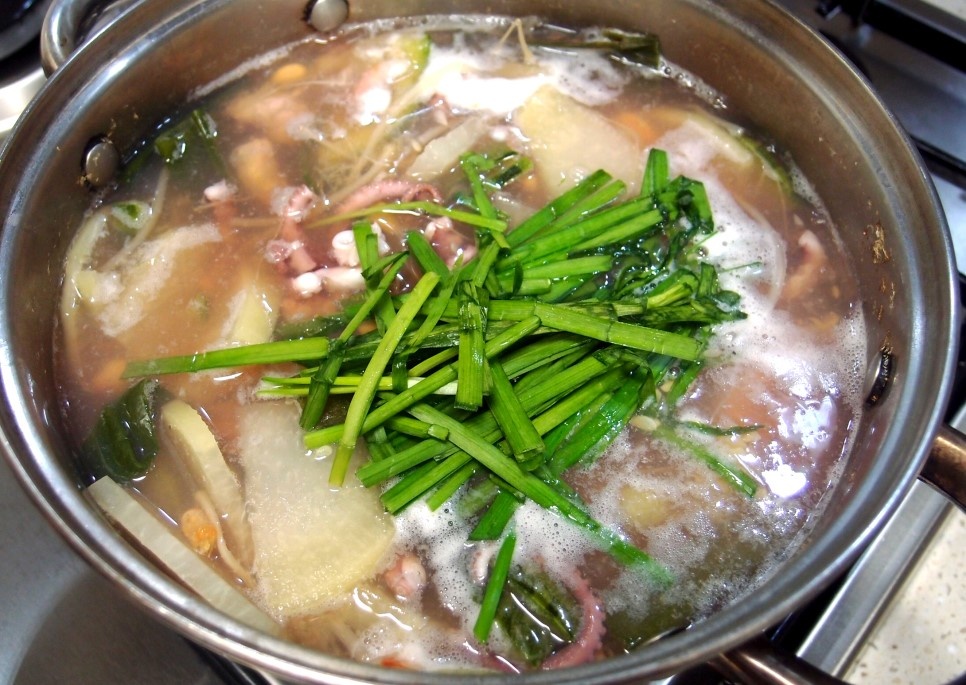Soft Octopus and Refreshing Broth Yeonpotang
#How to Make Delicious Yeonpotang Broth: Easy Homemade Recipe!

The perfect soup for a hangover or a refreshing meal! Learn how to easily make Yeonpotang with its wonderfully cool and clean broth. Savor the harmonious blend of tender octopus and clear vegetable stock.
Main Ingredients- 3 Octopuses
- 1/6 Korean radish (Mu)
- 1/3 Zucchini (Hobak)
- 1 bowl Bean sprouts (about 100g)
- 2 Tbsp Dried anchovies (for broth)
- 1 bunch Chives (Buchu)
- 1 Cheongyang pepper (spicy green chili)
- 1 Red chili pepper
- 1 tsp Minced garlic
- Green parts of 1 Leek (use only the green tops)
Cooking Instructions
Step 1
Prepare the vegetables that will give Yeonpotang its refreshing taste. Slice the Korean radish into thick, 0.5cm pieces. Cut the zucchini into half-moon shapes. Chop the green parts of the leek into 3-4cm lengths. Rinse the bean sprouts thoroughly. It’s important to cut these vegetables into large pieces so they can sufficiently flavor the broth.

Step 2
Arrange the thickly sliced Korean radish at the bottom of the pot. Add a generous amount of dried anchovies here to make the broth even more refreshing and flavorful. Dried anchovies are a secret ingredient for adding depth.

Step 3
Add the chopped leek and zucchini to the pot. Pour in enough water to cover the ingredients and bring it to a rolling boil over high heat. Once boiling, reduce the heat to medium and simmer for about 10-15 minutes to allow the flavors from the radish and zucchini to infuse into the broth.

Step 4
Once the broth has developed some flavor, add 1 tsp of minced garlic to enhance the aroma. Let it simmer for a bit longer to allow the garlic scent to meld with the broth.

Step 5
Now, add the rinsed bean sprouts and cover the pot with a lid. Cook for another 3-5 minutes, or until the bean sprouts are cooked but still crisp. Be careful not to overcook the bean sprouts, as they can become mushy.

Step 6
Meanwhile, prepare the octopus. Turn the octopus head inside out, remove the innards and beak, and wash it thoroughly. Rinsing it multiple times under cold water will ensure it’s clean.

Step 7
Check if the bean sprouts and radish are tender and the broth is clear and refreshing. At this point, the broth should already taste savory and deep.

Step 8
Adjust the seasoning of the broth. Salted shrimp is commonly used for seasoning. You can also add a little fish sauce or soy sauce for extra umami. Start with a small amount of salted shrimp and adjust to your preference.

Step 9
Finally, it’s time to add the octopus! Carefully place the prepared octopus into the simmering broth. Octopuses can become tough if overcooked, so once the broth returns to a boil, cook for just 1-2 minutes. (Optional: If you have bottle gourd (Bak), slicing it thinly and adding it to the pot can create an even more refreshing and deep flavor. If not, using just vegetables like radish, zucchini, bean sprouts, and leek will result in a delicious vegetable-based Yeonpotang.)

Step 10
The color of the broth has slightly changed with the addition of the octopus. The charm of Yeonpotang lies in its wonderfully cool and deep broth! Hot broth is always satisfying.

Step 11
Lastly, garnish the soup with freshly chopped chives. The fragrant chives will further enhance the refreshing taste of the Yeonpotang. Now, serve the finished Yeonpotang beautifully in bowls.

Step 12
Your refreshing and clean Yeonpotang, which feels like a breath of fresh air, is complete! The cooking process is incredibly simple, but once you taste it, you’ll be amazed by its deep and rich broth. It’s a perfect dish for special occasions or when you need a refreshing meal.




